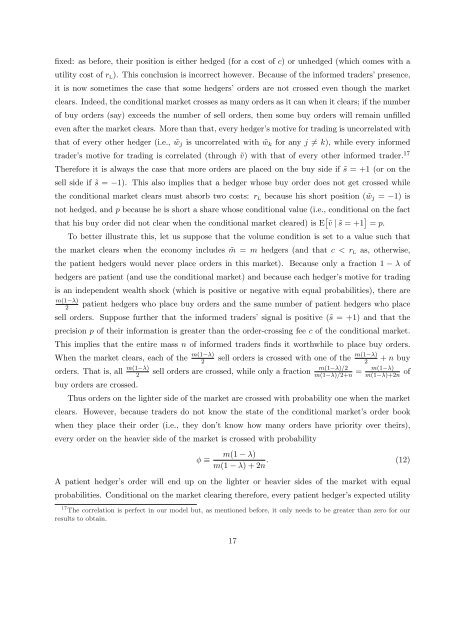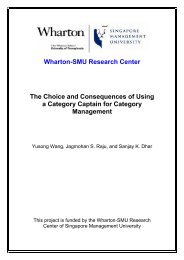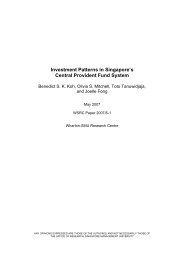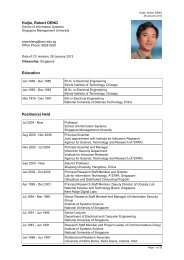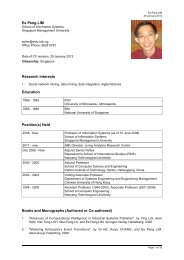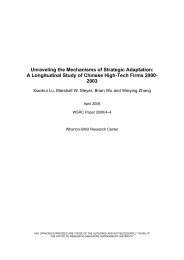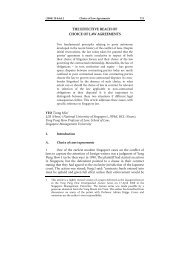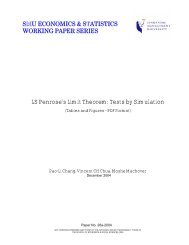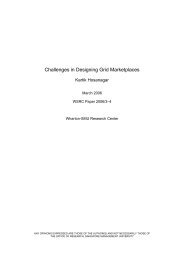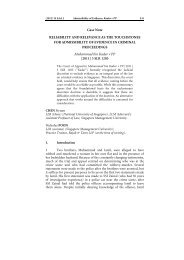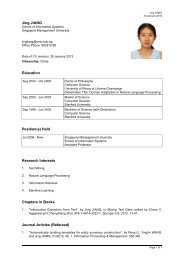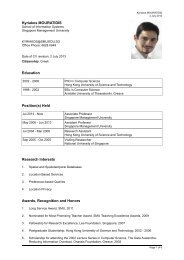The Benefits of Volume-Conditional Order-Crossing - Singapore ...
The Benefits of Volume-Conditional Order-Crossing - Singapore ...
The Benefits of Volume-Conditional Order-Crossing - Singapore ...
You also want an ePaper? Increase the reach of your titles
YUMPU automatically turns print PDFs into web optimized ePapers that Google loves.
fixed: as before, their position is either hedged (for a cost <strong>of</strong> c) or unhedged (which comes with a<br />
utility cost <strong>of</strong> r L). This conclusion is incorrect however. Because <strong>of</strong> the informed traders’ presence,<br />
it is now sometimes the case that some hedgers’ orders are not crossed even though the market<br />
clears. Indeed, the conditional market crosses as many orders as it can when it clears; if the number<br />
<strong>of</strong> buy orders (say) exceeds the number <strong>of</strong> sell orders, then some buy orders will remain unfilled<br />
even after the market clears. More than that, every hedger’s motive for trading is uncorrelated with<br />
that <strong>of</strong> every other hedger (i.e., ˜wj is uncorrelated with ˜wk for any j = k), while every informed<br />
trader’s motive for trading is correlated (through ˜v) with that <strong>of</strong> every other informed trader. 17<br />
<strong>The</strong>refore it is always the case that more orders are placed on the buy side if ˜s = +1 (or on the<br />
sell side if ˜s = −1). This also implies that a hedger whose buy order does not get crossed while<br />
the conditional market clears must absorb two costs: r L because his short position ( ˜wj = −1) is<br />
not hedged, and p because he is short a share whose conditional value (i.e., conditional on the fact<br />
that his buy order did not clear when the conditional market cleared) is E ˜v | ˜s = +1 = p.<br />
To better illustrate this, let us suppose that the volume condition is set to a value such that<br />
the market clears when the economy includes ˜m = m hedgers (and that c < r L as, otherwise,<br />
the patient hedgers would never place orders in this market). Because only a fraction 1 − λ <strong>of</strong><br />
hedgers are patient (and use the conditional market) and because each hedger’s motive for trading<br />
is an independent wealth shock (which is positive or negative with equal probabilities), there are<br />
m(1−λ)<br />
2<br />
patient hedgers who place buy orders and the same number <strong>of</strong> patient hedgers who place<br />
sell orders. Suppose further that the informed traders’ signal is positive (˜s = +1) and that the<br />
precision p <strong>of</strong> their information is greater than the order-crossing fee c <strong>of</strong> the conditional market.<br />
This implies that the entire mass n <strong>of</strong> informed traders finds it worthwhile to place buy orders.<br />
When the market clears, each <strong>of</strong> the m(1−λ)<br />
2<br />
sell orders is crossed with one <strong>of</strong> the m(1−λ)<br />
2<br />
orders. That is, all m(1−λ)<br />
2 sell orders are crossed, while only a fraction m(1−λ)/2<br />
m(1−λ)/2+n<br />
buy orders are crossed.<br />
+ n buy<br />
= m(1−λ)<br />
m(1−λ)+2n <strong>of</strong><br />
Thus orders on the lighter side <strong>of</strong> the market are crossed with probability one when the market<br />
clears. However, because traders do not know the state <strong>of</strong> the conditional market’s order book<br />
when they place their order (i.e., they don’t know how many orders have priority over theirs),<br />
every order on the heavier side <strong>of</strong> the market is crossed with probability<br />
φ ≡<br />
m(1 − λ)<br />
. (12)<br />
m(1 − λ) + 2n<br />
A patient hedger’s order will end up on the lighter or heavier sides <strong>of</strong> the market with equal<br />
probabilities. <strong>Conditional</strong> on the market clearing therefore, every patient hedger’s expected utility<br />
17 <strong>The</strong> correlation is perfect in our model but, as mentioned before, it only needs to be greater than zero for our<br />
results to obtain.<br />
17


